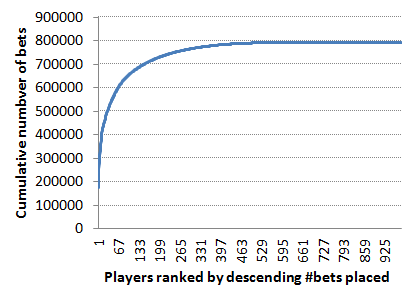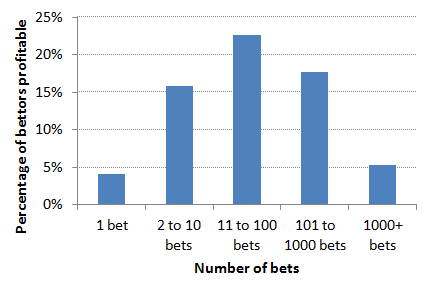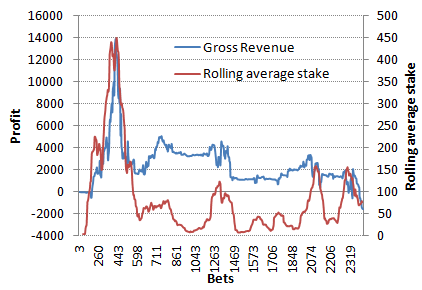How Many People Win at Sports Betting Revisited
Posted 11th September 2018
Nearly four years ago, I wrote an article on Football-Data asking the question: How Many People Win at Sports Betting?. Since then, I have published my book Squares and Sharps which took a very realistic and sobering view of sports bettors' prospects: yes, there are winners, but hardly any of them are doing so because of skill; almost all are lucky, and inevitably regress to the mean in the end.
Yesterday, I was promoted to think about this question again in the context of soft bookmakers who restrict winning customers to small stakes. It was suggested that soft books will limit winning customers to around £2,000 for lifetime profits before investigating your account to see whether you might hold positive expected value.
I decided to take a look at an old affiliate account - skybet - where it is possible to analyse total wagers for each referred player, along with total profits and losses. The analysis period in question ran from 6th January 2011 to 3rd October 2017, when skybet ceremoniously shafted all their affiliates by closing the programme (well, not quite all, some of the tipster affiliates who had given the industry a bad name by earning from tips that are designed to lose were kept on, but that's another story).
Over the period there were a total of 978 referred customers who bet at least once, placing a total of 795,013 bets. The distribution of bets placed by these customers followed Pareto, a power law distribution more commonly described by the 80-20 rule - that is 80% of the bets are placed by 20% of the customers. In this case, it was actually about 92%. Indeed, the highest betting 1% of the sample accounted for 50% of the bets. And the player with the most accounted for 22.4% of the bets (178,346): incredible! The first figure shows a cumulative frequency distribution of how those customers contributed to the overall number of bets in the sample.

Of the 978 bettors, 143 or 14.6% of them were profitable. This is very much in line with the proportion of bettors reported as profitable by a 2007 study analysing the profitability of bettors at a similarly soft sportsbook, bwin, who were active during 8 months in 2005. I have reported the findings of this study in my book.
Naturally, I have no idea whether any of them have had their betting activity restricted by skybet, although I suppose a more detailed investigation into the sequence of bets by a customer might reveal obvious clues. For example, the most profitable customer in the sample of 978 who won £10,034.50 between September 2011 and August 2015, suddenly ceased activity having turned a £6k loss into a £10k profit over the course of the final 6 weeks with stakes typically several hundred pounds per bet. Of course, it's entirely possible he did the sensible thing and quit whilst he was ahead. However, a single bet placed 10 months later that had a stake of just £20 would rather suggest a limitation was the more likely explanation. Of course, we will never know.
The 2nd most profitable customer made just £1,442.27 with 4 others showing profits of over £1,000. This could offer some confirmation to the anecdotal suggestion of a £2,000 account profit limit. Alternatively, it simply might confirm that it's very hard to make a living from sports betting. With that in mind, I next looked how the percentage of profitable bettors varied with the number of bets they place. If any bettors are skilled we would expect them to survive longer in the game, place more bets, and show superior profits, with disproportionately more of them showing profitability. That is not what we see.
The next chart breaks the 978 customers into 5 groups: those who placed only 1 bet (171 of them), those placing 2 to 10 bets (183), those placing 11 to 100 bets (212), those placing 101 to 1,000 bets (299) and finally those placing more than 1,000 bets (113).

Just 4.1% of customers who placed only 1 bet made a profit. The likely explanation is that those who won their first bet were far more likely to go on to place more, whilst those who lost disproportionately may have got cold feet and never bothered to return. Additionally, many of those losing bets may have been at long odds with a lower probability of success.
The group most likely to be profitable were those placing 11 to 100 bets (22.6%). Having previously made the argument that those who place more bets increasingly become more profitable, such a finding would fit with that hypothesis. I don't think that is the explanation. Why? The clue is what happens with the final two groups, where the percentage of profitable customers falls. By the time customers in this sample are placing over 1,000 bets, just 5.3% of them are profitable (only 6 customers), and when ranking the players in descending order of bets placed, it is not until the 53rd player before we find one that is profitable (2,582 bets with a 1.5% yield). This is an example of regression to the mean. Good luck runs out, and customers' performances starting moving back towards expectation. The longer most bettors bet, the more likely it is that they will be showing losses. Furthermore, of the 6 profitable customers who placed over 1,000 bets, three of them were only marginally so. The yields were as follows: 11.3%, 9.9%, 6.9%, 1.5%, 1.0% and 0.8%.
As a whole, the 978 customers lost 9.65% on turnover, whilst those making over 1,000 bets lost 8.97%, although of course it should be acknowledged that this figure is heavily biased by the single customer placing 178,346 bets. We don't know what the average betting odds these long term players were wagering. Assuming average odds of 2, 3 and 5, a 10-000 run Monte Carlo simulation confirms that a bettor with a -8.97% expectation will have a 0.14%, 2.14% and 6.8% probability respectively of still showing a profit after 1,000 bets (with standard deviations of 3.2%, 4.3% and 6.1% respectively in the simulated yields). The longer the odds, the greater the variances, and the greater the probability of doing very well (but also very badly) because of good (bad) luck. Recall there were 5.3% of 1,000+ bet customers in this sample who had achieved a profit. These figures could imply that most of these bettors were higher-odds players, or at the very least there was a wide range in the sorts of odds each of them were preferring to bet. Given the standard deviation in yield across these 113 customers was 9.7%, this is certainly a credible explanation. Alternatively, it could mean that some of those 6 players (presumably the 3 with the biggest yields) were exhibiting genuine skill.
A closer look at the best three long term players suggests none of them were limited. The player with 11.3% (1,736 bets) was a frequent bettor during the period May 2011 to September 2017. However, his stakes were small, typically £1 or 50p, and not even the worst of soft bookmakers is going to limit such a customer, no matter how skilful they are (the account's total gross profit over the 6 year period was just £246.51). The player with a 9.9% yield from 1,207 wagers between June 2011 and September 2017 placed larger stakes, but against nothing that would break skybet's balls (typically £5 or £10). He was also a frequent poker player, and what skybet had to payout for his betting activity, they more than made back in poker rakes. Finally, the player with a 6.9% yield from 1,115 bets was also similarly moderate staking (typically £5) and also played casino. Sportsbooks will always do their best to accommodate casino players because they know it's impossible for them to show positive expectation.
A more interesting time series is provided by a 1000+ bet customer who staked much more heavily, placing 2,412 bets during the period July 2012 to May 2015, at an average stake size of £90. The customer finished with a yield of -0.7%, but this doesn't tell the whole story as the final chart reveals.

The early part of their betting was characterised by a very dramatic profit taking followed by loss making, explained almost entirely by the money management strategy they followed. This was either some form of Kelly plan, or more simply just ramping up stakes after previous wins. the bankroll reached a maximum of close to £14,000 after 76 bets, before crashing almost as quickly. At its highpoint the yield was 20%. One may wonder why skybet chose not to restrict such a customer. I suppose the devil is in the detail. Given that they didn't we must speculate that skybet had taken the view that this customer had been lucky, was not beating the closing line, and showing staking patterns that would indicate they would hand all their profits back in due course. They did, and a further 3 years of quieter betting which followed finally ended with the account showing a small loss.
This was back in 2012. Given the increased attention in recent months to the prevalence of account restrictions, might we also wonder whether skybet would have reached a different decision today? Again, it's just speculation. However, all this ignores the broader observation that it's pretty hard being a long term winner, more still one who has managed it with more than just good fortune. Yet again the distribution of performances across customers broadly matches what we could replicate via coin tossing. If any of those long term players were genuinely winning through skill, they are hard to spot.
|





